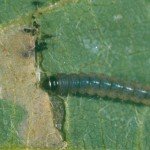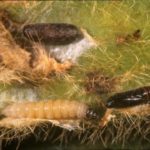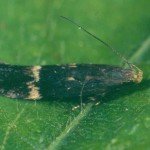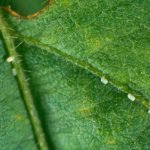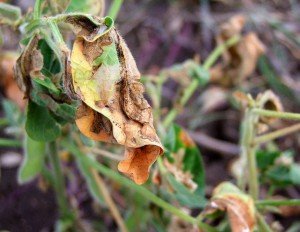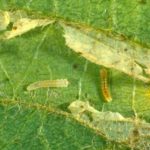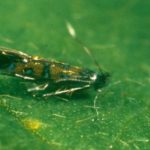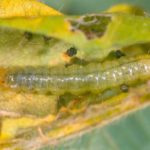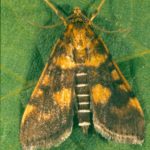Significant soybean moth flights have been observed recently in some coastal Burnett soybean crops. Little damage has been observed to date, but high numbers of adult moths are an early warning sign of potential severe defoliation. Soybean moth is usually a minor soybean pest but in spasmodic major outbreaks, larval populations can exceed 1,000 per square metre.
Identification
Soybean moths (Aproaerema simplexella) are small (6 mm long) and have dark folded wings with a white transverse band. Their small, white and slightly elongated eggs are often laid on leaf veins on the underside of leaves. The first sign of larval infestation are the pale semi-transparent straw-coloured leaf mines within which the larvae feed. Soybean moth larvae only grow to 7 mm in length, and are pale grey-green with a dark head. Larvae entering the non-feeding pre-pupal stage turn pale cream before pupating in folded leaves.
- Soybean moth larvae (6mm) and typical leaf mining damage
- Pre-pupal larva and soybean moth pupa. The pupa above them has been parasitised
- Soybean moth adult (6mm long)
- Soybean moth eggs (2x4mm)
Damage
A leaf feeding pest that feeds inside the leaves in leaf mines, soybean moth larvae are present in most soybean crops but usually at very low densities with only one larva and leaf mine per infested leaf. However in severe infestations, there may be numerous leaf mines per leaflet. These leaf mines increase in size as larvae grow, and, in extreme infestations, may eventually merge, killing all photosynthetic (green) leaf tissue. In such cases there can be in excess of 1,000 larvae per square metre.
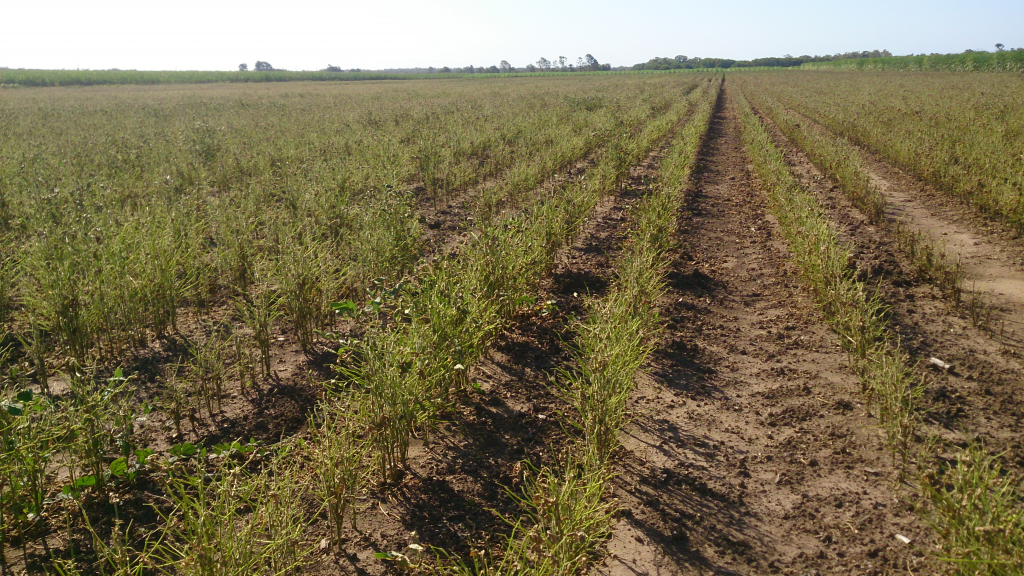
Severe soybean moth damage at Bundaberg in 2017 with near 100% defoliation (leaf death). Image by Matt Leighton – Bundaberg Sugar.
Other leafminers and leaf rollers: Soybean moth damage can easily be confused with that of the soybean leaf miner (Lithocolletis aglaozona) which also mines in leaves. However soybean leaf miner are much smaller, only reaching 2-3 mm in size, and have a noticeable thickening of the body behind the head. The soybean leafminer moth also has folded wings but is very small (2 mm long) with shining orange wings with white spots ringed with black.
- Soybean leafminer larvae (2mm) inside cut-open leaf mine
-
Soybean leafminer adult
(6mm long)
Leaf rolling can also be caused by the much larger legume web-spinner (Omiodes diemenalis) (14 mm) which is a brighter green, webs leaves together, and feeds externally within the rolled up leaf, rather than mining within the leaf. The legume web-spinner moth is much larger (13 mm wingspan) and is brown with yellow markings.
- Legume webspinner (14mm) inside rolled leaf
- Legume webspinner adult (12mm long; 14mm wingspan)
Scouting
Scout crops regularly to pick up the early stages of damaging populations, specifically the numerous pale small feeding mines per leaflet. Note that stressed sections of a crop are often more heavily infested. Infestations may also be higher along the edge of the crop adjacent to trees. Where large numbers of moths are present but no damage is obvious, wait until damage appears to determine if the infestation is likely to exceed the prescribed % defoliation thresholds below.
Thresholds
Thresholds are based on percentage defoliation or leaf death. In vegetative crops, 33% leaf tissue death (mining) can occur before yields are compromised. However, tolerable defoliation falls to less than 20% during pod-fill.
Control
Soybean moth larvae are easily controlled with abamectin at 300 mL/ha under Permit 86185 (valid until 30 April 2023). Note that larvae in the pale pre-pupal stage will have stopped feeding and will not be controlled by the insecticide. Feeding larvae die inside the leaves and turn an opaque grey. Abamectin has a 28-day withholding period, so do not apply if there is less than 4 weeks to harvest.
Article by Hugh Brier and Trevor Volp. Insect images by Joe Wessels.
Hugh Brier, Principal Entomologist DAF Kingaroy Q 4610.
Email: [email protected] Phone 0741 821 840 or Mob 0428 188 069
Trevor Volp, Research Scientist, DAF Toowoomba Q 4350
Email: [email protected] Phone 0745 284 180

